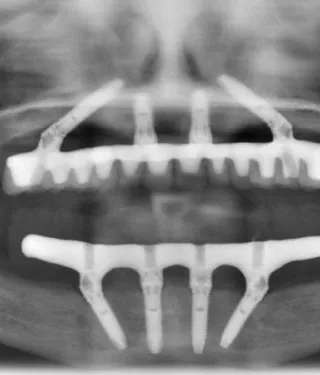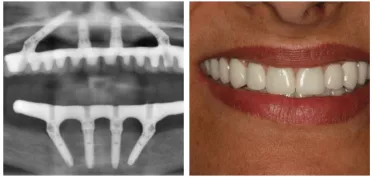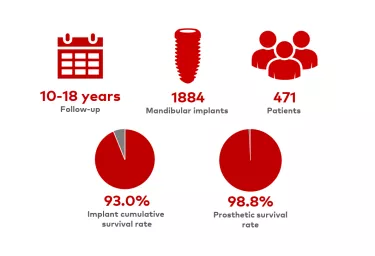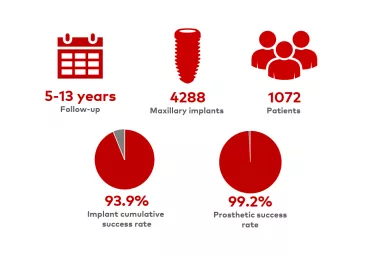
All-on-4® treatment concept: High rates of long-term clinical success
As global life expectancy continues to rise, our aging populations face increasing burdens of chronic disease and disability.1 Edentulism is a disability significantly impacting the quality of life of patients.1,2 Affecting an estimated 302 million people globally, edentulism increased 27.3% over a single decade.1
For many edentulous patients, the optimized esthetics, high stability and retention offered by a fixed restoration is an ideal solution for their dissatisfaction with the functionality and esthetics of dentures.3,4,5 The current expert consensus is that an implant-supported restoration should become the first choice for edentulous patients.6 For clinicians, addressing this continuing unmet medical need with advanced and clinically proven long-term solutions can help build their practice for the future.
One of the best-documented restorative concepts for edentulous patients is a fixed, full-arch prosthesis, immediately loaded onto two axial implants in the anterior and two tilted implants in the posterior.7,8 In the words of Paulo Maló, the All-on-4® treatment concept is “demonstrated to be a predictable treatment modality for full-arch rehabilitation with good results in the short, medium and long term”.7
- 1. Patient treated with the All-on-4® treatment concept in both the mandible an…
- 2. In the mandible: Predictable outcomes after 10–18 years follow-up
- 3. In the maxilla: High clinical success rates after 5–13 years of follow-up
- 4. Low rates of biological complications
- 5. The All-on-4® treatment concept is a fixed, full-arch treatment with up to 1…
Patient treated with the All-on-4® treatment concept in both the mandible and maxilla
Since 1998, more than 150,000 people have been treated with this procedure.9 With longstanding use of such a well-established restorative procedure, one would be right to expect that very long-term clinical evidence of its effectiveness and safety would now be available. This year, two publications from the Maló Clinic in Lisbon, Portugal, provided just that.7,8
In the mandible: Predictable outcomes after 10–18 years follow-up
Clinical outcomes after 10–18 years of follow-up were investigated among patients who had a mandibular rehabilitation with the All-on-4® treatment concept.7
The cumulative prosthetic survival rate was 98.8% (only 4 out of 471 patients lost their prostheses due to implant failures). Also, the implant cumulative survival and success rates* were 93.0% and 91.7%, respectively, from a total of 1,884 implants.
A total of 281 (out of 320) patients with mandibular restorations had periapical radiographs both from the day of surgery (baseline) and their 10-year follow-up visit. The average marginal bone loss was −1.7 mm (95% confidence interval: −1.6, −1.9 mm). Fewer than 10% of patients (n=27) exhibited >3 mm bone loss around their implants, with smoking (three-fold increased risk) and prior implant failure (almost four-fold increased risk) being the two most important risk indicators.
Mandibular implants supporting the All-on-4® treatment concept showed predictable outcomes over up to 18 years of follow-up.7
In the maxilla: High clinical success rates after 5–13 years of follow-up
Clinical outcomes after 5–13 years of follow-up were evaluated among patients who underwent a maxillary rehabilitation using the All-on-4® treatment concept.8
The prosthetic success rate was 99.2%; only 9 out of 1,072 patients lost their prostheses due to implant failures. The implant cumulative survival and success rates were 94.7% and 93.9%, respectively, from a total of 4,288 implants.
Among patients who had periapical radiographs from the day of surgery and after 10 years (n=129), the average marginal bone loss was −1.67 mm (95% confidence interval: −1.58, −1.77 mm). Patients who were smokers exhibited the greatest risk of increased marginal bone loss (a 67% increased risk for MBL >2.8 mm at 5 years).
Maxillary implants supporting the All-on-4® treatment concept showed predictable outcomes at up to 13 years of follow-up.9
Low rates of biological complications
Clinicians understand that biological and mechanical complications can occur with full-arch restorations, especially over a 10+ year time horizon.
In the two reports from the Malo Clinic, the incidence of biological complications at the implant level was 11.8% in the mandible (223/1,884 implants) and 7.8% in the maxilla (312/4,288 implants). Biological complications in the mandible were significantly associated with the previous failure of a neighbouring implant, smoking and systemic conditions, e.g. patients with cardiovascular disease or diabetes. In the maxilla, the main risk indicators were age and smoking. Smokers had a 57% increased risk of biological complications compared to nonsmokers.
During the up to 18-year follow-up period in the mandible, mechanical complications occurred in 29.5% of the provisional and 36.7% of the final prostheses. A considerable proportion of these were minor: the loosening of abutment or prosthetic screws in the provisional or definitive prosthesis. The lowest rates of mechanical complications were observed in patients with definitive prostheses comprising a titanium framework and all-ceramic crowns. In the maxilla, mechanical complications occurred in 58.8% of provisional prostheses and 7.3% of the final prostheses.
The All-on-4® treatment concept is a fixed, full-arch treatment with up to 18 years of documented clinical success
These two retrospective studies are real-world data unparalleled in their length of follow-up time and quantities of patients and implants. The impressive implant- and prosthetic success rates, together with preservation of marginal bone levels, confirm that the All-on-4® treatment concept is a predictable and effective long-term solution for patients burdened with edentulism. Also, by understanding the patient-specific factors such as smoking, age, gender and medical background, clinicians may optimize future outcomes when transforming patients’ smiles and lives.
* Implant success was based on the Maló Clinic success criteria: (1) implant fulfilled its intended function as support for reconstruction; (2) implant was stable when individually and manually tested; (3) no signs of persistent infection that could jeopardize the implant outcome; (4) no radiolucent areas around the implants, ; (e) good esthetic outcome of the rehabilitation; and, (5) allowed construction of a fixed prosthesis, which provided the patient with comfort and good hygienic maintenance.10
References
1. GBD 2016 Disease and Injury Incidence and Prevalence Collaborators. Global, regional, and national incidence, prevalence, and years lived with disability for 328 diseases and injuries for 195 countries, 1990-2016: a systematic analysis for the Global Burden of Disease Study 2016. Lancet 2017;390(10100):1211-1259.
Read on PubMed
2. Yamada J, Kori H, Tsukiyama Y, et al. Immediate loading of complete-arch fixed prostheses for edentulous maxillae after flapless guided implant placement: a 1-year prospective clinical study. Int J Oral Maxillofac Implants 2015;30(1):184-193.
Read on PubMed
3. Albaker AM. The oral health-related quality of life in edentulous patients treated with conventional complete dentures. Gerodontology 2013;30(1):61-66.
Read on PubMed
4. Sivaramakrishnan G, Sridharan K. Comparison of implant supported mandibular overdentures and conventional dentures on quality of life: a systematic review and meta-analysis of randomized controlled studies. Aust Dent J 2016;61(4):482-488.
Read on PubMed
5. Emami E, Michaud PL, Sallaleh I, Feine JS. Implant-assisted complete prostheses. Periodontol 2000 2014;66(1):119-131.
Read on PubMed
6. Feine JS, Carlsson GE, Awad MA, et al. The McGill consensus statement on overdentures. Mandibular two-implant overdentures as first choice standard of care for edentulous patients. Montreal, Quebec, May 24-25, 2002. Int J Oral Maxillofac Implants 2002;17(4):601-602.
Read on PubMed
7. Malo P, de Araujo Nobre M, Lopes A, et al. The All-on-4 treatment concept for the rehabilitation of the completely edentulous mandible: A longitudinal study with 10 to 18 years of follow-up. Clin Implant Dent Relat Res 2019;21(4):565-577.
Read on PubMed
8. Malo P, de Araujo Nobre M, Lopes A, et al. The All-on-4 concept for full-arch rehabilitation of the edentulous maxillae: a longitudinal study with 5-13 years of follow-up. Clin Implant Dent Relat Res 2019;21(4):538-549.
Read on PubMed
9. Nobel Biocare. Data on File.
10. Maló P, de Araújo Nobre MA, Ferro A, Parreira GG. Five-year outcome of a retrospective cohort study comparing smokers vs. nonsmokers with full-arch mandibular implant-supported rehabilitation using the All-on-4 concept. J Oral Sci 2018;60(2):177-186.
Read on PubMed


